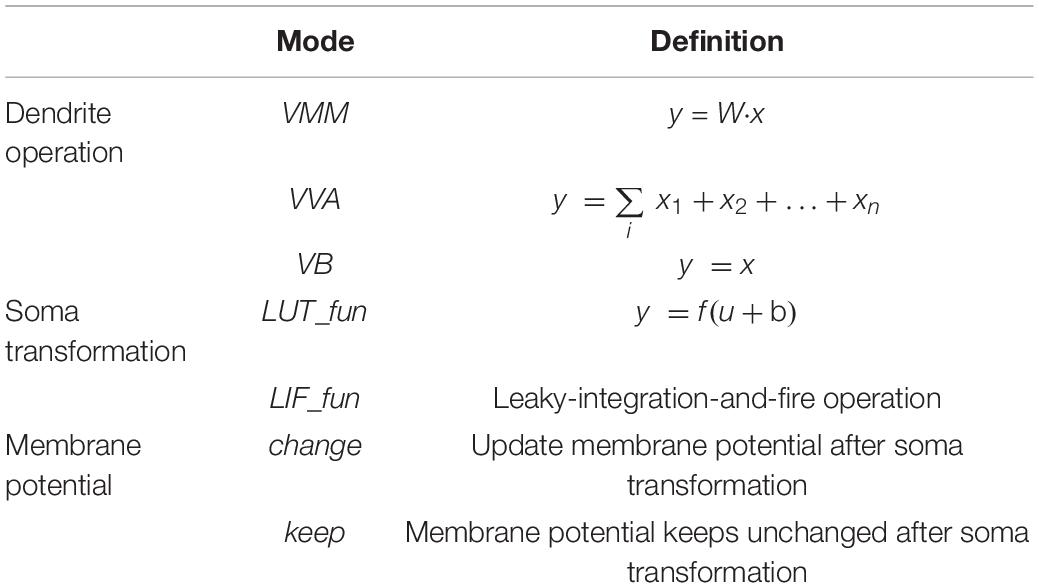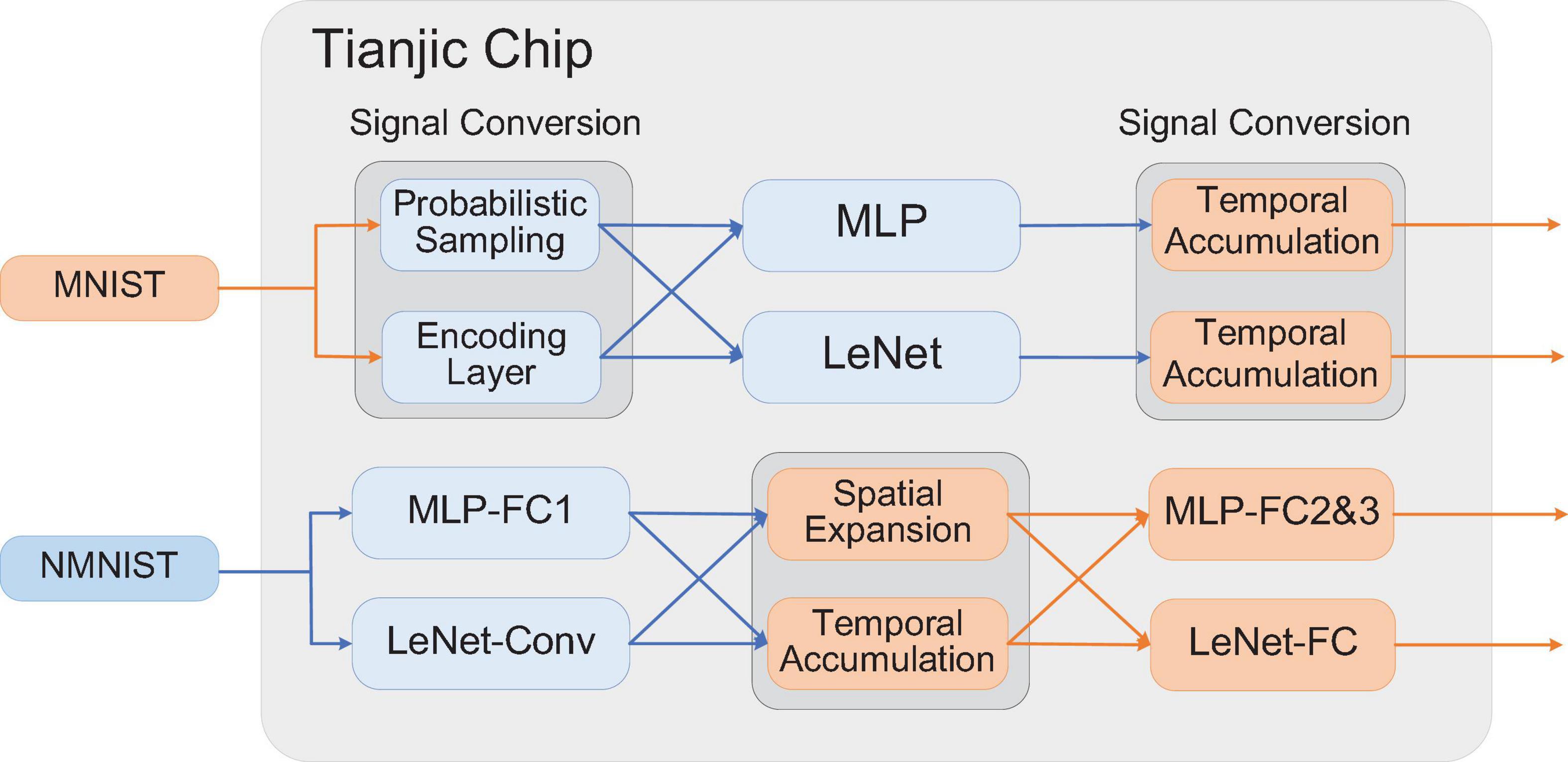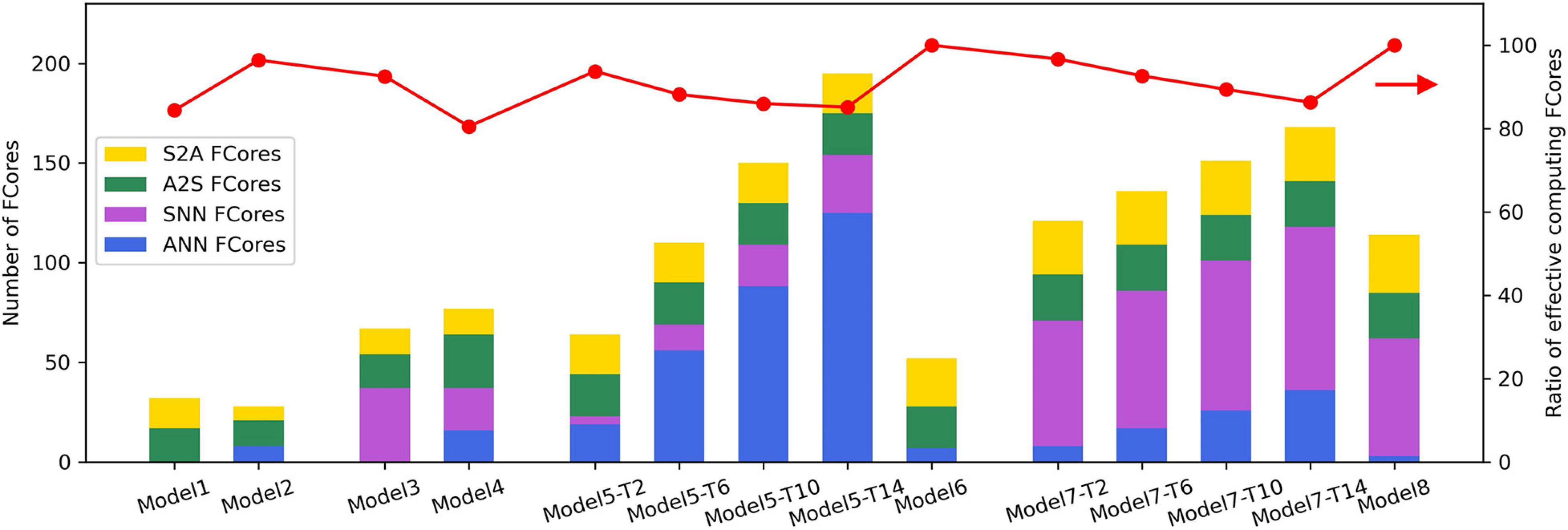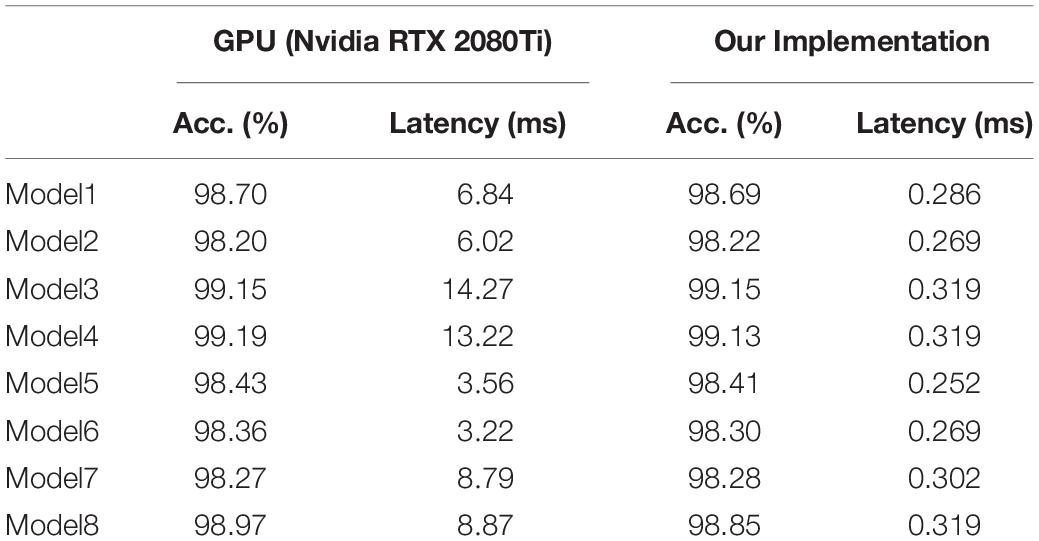- Department of Precision Instrument, Center for Brain-Inspired Computing Research (CBICR), Beijing Innovation Center for Future Chip, Optical Memory National Engineering Research Center, Tsinghua University, Beijing, China
Integration of computer-science oriented artificial neural networks (ANNs) and neuroscience oriented spiking neural networks (SNNs) has emerged as a highly promising direction to achieve further breakthroughs in artificial intelligence through complementary advantages. This integration needs to support individual modeling of ANNs and SNNs as well as their hybrid modeling, which not only simultaneously calculates single-paradigm networks but also converts their different information representations. It remains challenging to realize effective calculation and signal conversion on the existing dedicated hardware platforms. To solve this problem, we propose an end-to-end mapping framework for implementing various hybrid neural networks on many-core neuromorphic architectures based on the cross-paradigm Tianjic chip. We construct hardware configuration schemes for four typical signal conversions and establish a global timing adjustment mechanism among different heterogeneous modules. Experimental results show that our framework can implement these hybrid models with low execution latency and low power consumption with nearly no accuracy degradation. This work provides a new approach of developing hybrid neural network models for brain-inspired computing chips and further tapping the potential of these models.
Introduction
Neural networks have been widely used to deal with intelligence problems. In general, they can be divided into non-spiking artificial neural networks (ANNs) (Lecun et al., 2015) and spiking neural networks (SNNs) (Maass, 1997; Ghosh-Dastidar and Adeli, 2009). These two types of neural models are distinct in information representation and processing. In ANNs, information is propagated with multi-valued data. Intensive representation makes ANNs achieve high accuracies in a myriad of tasks, such as image classification (He et al., 2016), speech recognition (Lam et al., 2019), and action recognition (Wu et al., 2016). In contrast, SNNs encode information in event-driven binary spike trains. Through internal neuron dynamics to memorize spatio-temporal information, SNNs show advantages in various scenarios with rich temporal information and sparse data streams (Shi et al., 2017; Haessig et al., 2018; Wu et al., 2019). Owing to their different advantages, in recent years there is a growing trend of integrating ANNs and SNNs to explore hybrid neural networks (HNNs) toward artificial general intelligence (Marblestone et al., 2016; Zhang et al., 2016; Ullman, 2019). For example, in some cases of event-driven tasks (Srinivasan and Roy, 2019; Lee et al., 2020), researchers use SNN modules for abstracting sparse temporal information, and further combine ANN modules for improving the classification performance. Similarly, in some cases of static image processing tasks (Kheradpisheh et al., 2018; Chancán et al., 2020), researchers use ANN modules to extract the edge contrasts in images and further process them with SNN modules for low power consumption. Besides, ANNs and SNNs also work collaboratively to perform complex tasks in Pei et al. (2019); Yang et al. (2019).
Hybrid neural networks have a promising perspective on the development of artificial general intelligence. However, by far these models are mainly studied and implemented on general-purpose platforms (i.e., CPU or GPU) (Kheradpisheh et al., 2018; Srinivasan and Roy, 2019; Chancán et al., 2020; Lee et al., 2020). On the other side, HNNs retain the basic properties of neural networks, being promising in high-efficiency implementation on domain-specific hardware platforms (Sze et al., 2017). However, their unique cross-paradigm mechanisms, such as the mixed dataflow of multi-valued data and spike trains, hinder the implementation on dedicated platforms, thereby slowing down the exploration of diverse cross-paradigm integration. Thus, it is highly expected to develop a general scheme of implementing HNNs on dedicated platforms for high efficiency, which can facilitate the iteration of software and hardware co-optimization and eventually promote the development of hybrid neural models.
There are two challenges in implementing HNNs on dedicated hardware platforms. The first is to support the simultaneous execution of ANN and SNN computing paradigms. In the traditional ANN or SNN field, each has its respective hardware platforms to support their efficient execution, e.g., deep learning accelerators for ANNs (Chen et al., 2014; Han et al., 2016; Jouppi et al., 2017; Chen et al., 2019) and neuromorphic chips for SNNs (Furber et al., 2014; Merolla et al., 2014; Davies et al., 2018). However, due to the significant differences between ANNs and SNNs in terms of information representation, computation philosophy and memory organization, the basic operators and data transmission methods of these two types of platforms are incompatible. Therefore, neither of the above hardware platforms can simultaneously support the execution of ANNs and SNNs, which impedes the implementation of HNNs. The second is the hybrid data interactions between ANNs and SNNs. In HNNs, the hybrid data interaction modules connect ANNs and SNNs, which have a non-negligible impact on the performance of the models when implemented on a hardware platform. Usually, the hybrid data interaction results in at least two-fold computational costs: (1) realizing signal conversion between multi-valued data and spike trains will bring extra resource consumption and execution delay; (2) the signal conversion and timing configuration will in turn affect the resource consumption and execution time of ANN and SNN modules. In current dedicated hardware platforms, signal conversion at the input interface needs to be implemented when the external data cannot match the information format transmitted and processed internally. Therefore, extra devices and resources are usually required, such as “spike generator” (Esser et al., 2016; Shukla et al., 2019) or “frame maker” (Shukla et al., 2019). However, this separative method will not only destroy the continuity of hardware execution to a certain extent, but also make it difficult to comprehensively measure and evaluate the implementation cost of signal conversion and network computing via a unified standard.
In this paper, we provide a systematic scheme of implementing HNNs on many-core neuromorphic architectures based on software-hardware cooperation from the perspectives of hardware features and mapping framework. First, we use a new type of cross-paradigm Tianjic chip (Pei et al., 2019) as the hardware infrastructure. From the aspects of basic operations, communication method, and timing execution mechanism, the hardware features that support the implementation of HNNs are abstracted. On this basis, we propose an end-to-end mapping framework to implement HNNs on many-core neuromorphic chips. Inspired by the modular approach, we divide the implementation of HNNs into the pure computing modules of single ANNs and SNNs, and the signal conversion modules between them. The pure computing modules can be realized by using the existing single-paradigm mapping methods (Esser et al., 2013; Deng et al., 2018; Ji et al., 2018). To realize the hybrid data interactions between ANNs and SNNs, configuration schemes for four typical signal conversions methods are established. Besides, we also develop a global timing adjustment mechanism to match the different working periods among these modules. Taking some HNN models as examples, we analyze their performance in terms of resource overhead, running speed, and energy consumption when deployed on the Tianjic chip. This implementation framework provides a generic approach for developing hybrid neural models through the hardware-software collaboration.
The rest of this paper is organized as follows. Section “Hardware Infrastructure” introduces the basic operation, communication format, and timing schedule mechanism of the Tianjic chip from the perspective of hardware feature abstraction. Section “End-to-End Mapping Framework” shows the characteristics of neural networks’ execution on many-core neuromorphic chips, and presents the proposed end-to-end mapping framework for hybrid neural models. The resource overhead, timing analysis, and energy consumption of the example hybrid networks are reported in Section “Experimental Results.” Finally, we come up with the overall conclusions and carry out further discussions in Section “Conclusion and Discussion.”
Hardware Infrastructure
Tianjic adopts a unified, configurable, and scalable architecture to support cross-paradigm computing, which provides a general platform for the separative execution or hybrid computing of ANNs and SNNs. In this section, we will briefly introduce the overall architecture of the Tianjic chip (see Figure 1), including its basic operation, communication format, and timing schedule mechanism which support our mapping framework.
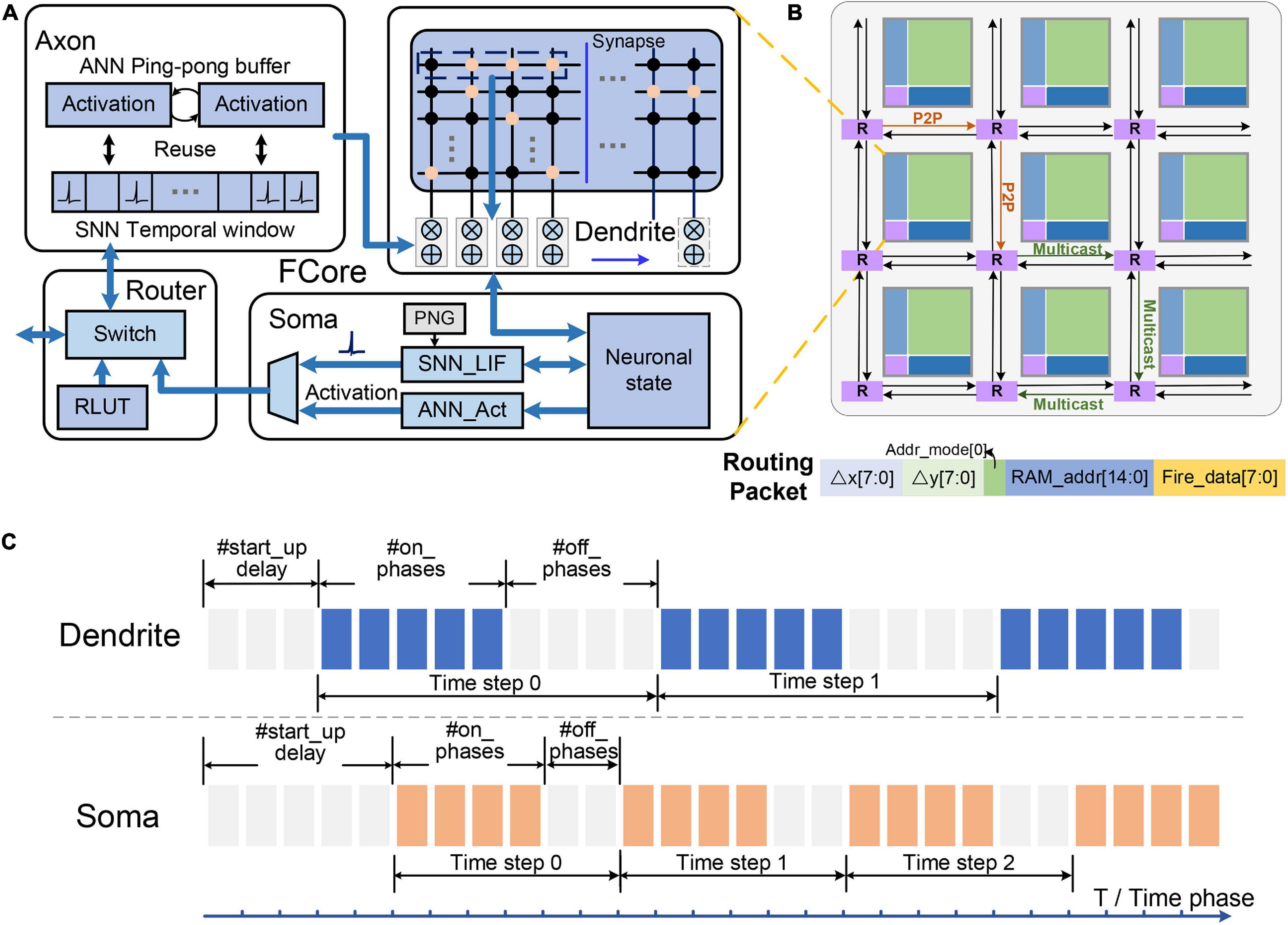
Figure 1. Illustration of the Tianjic chip architecture: (A) fine-grained configurable operation modules; (B) unified communication format; (C) adjustable timing schedule.
Fine-Grained Configurable Operation Modules
Functional core (FCore) is the basic unit of the Tianjic chip, which consists of four modules, including an axon for input organization, a dendrite (with synapses) for integration operations, a soma for non-linear neuronal transformation, and a router for activation transmission (Figure 1A). Each module can be configured to work in different modes or perform different operations, which enables the chip to support both ANN and SNN models. Among these modules, the dendrite and the soma are the main computing engines. Equipped with the synapse memory, the dendrite constitutes a 256 × 256 virtual crossbar, which can realize various vector and matrix operations. Table 1 lists the vector and matrix operations used in this paper, including vector-matrix multiplication (VMM), vector-vector accumulation (VVA) and vector buffering (VB).
The calculation results of the dendrite are updated into a memory shared with the soma and the soma generates the neuronal output according to the updated membrane potential. By combining some basic calculations, the soma can realize a variety of non-linear transformations in different modes of ANNs and SNNs. In an ANN-mode soma, arbitrary activation function can be supported by a configurable lookup table (LUT). In an SNN-mode soma, its internal operation corresponds to the leaky-integration-and-fire (LIF) operation of spiking neurons. Furthermore, some more complicated operations, such as threshold adaption and random firing, can also be enabled through specific configurations. After the transformation of the soma, the update mode of the shared memory can be divided into keep or change, corresponding to whether the membrane potential stored therein will be changed according to the calculation result of the soma.
Unified Communication Format
These FCores are connected by a multifunctional and scalable routing network, and arranged in a 2D mesh topology. The routing network is composed of the router and the axon in each FCore, which are responsible for sending and receiving information respectively. In the router, both artificial and spiking neurons transmit their information through a unified communication format. In addition to the address and control information in the traditional AER (Address-Event Representation) protocol (Mahowald, 1993), the routing packet can also carry different multi-valued data in this unified communication format. Specifically, this multi-valued data represents the efferent activation value of artificial neurons in the ANN mode and the state information of spiking neurons (e.g., membrane potential) in SNN mode. Notably, the router generates a packet only when a spike is generated and needs to be transmitted, which is in an even-driven manner.
As shown in Figure 1B, these data packets can be delivered to single or multiple arbitrary target FCores through point-to-point (P2P) or multicast routing. When arriving at the destination FCore, the packet is decoded to a binary spike or multi-valued activation according to the working mode of the local axon. In the ANN mode, the axon directly obtains multi-value activations from routing packets and store them in a ping-pong buffer. In the SNN mode, the axon stores spike trains of each input within a historical temporal window. Via a timing factor calculator (TFC), the spike trains can be weighted and summed according to the timing factors. Based on this cross-paradigm and unified data communication format, we can easily realize the basic connection structure that supports mixed dataflows as described in section “Execution of Neural Networks on Neuromorphic Chips.”
Adjustable Timing Schedule
The timing execution mechanism in the Tianjic chip has two typical characteristics: the reconfigurable phase pattern in an execution time step and the independent working schedule of each FCore’s modules.
Reconfigurable phase pattern in an execution time step: There are two levels of execution period in Tianjic, which are time phase and time step. The time phase is a basic computational period to perform a round of computation, and the time step includes multiple time phases and therefore is a higher level of execution period. As shown in Figure 1C, the number of time phases in a time step and their on-off (enable and disable) pattern are controlled by timing registers (i.e., start-up delay, #on_phases and #off_phases). This configurable phase pattern provides a flexible support for matching different execution periods of ANNs and SNNs.
Independent working schedule of each FCore’s modules: In a time phase, the dendrite integrates the inputs stored in the axon and updates the membrane potential into the shared memory, meanwhile the soma performs non-linear transformation given the integrated membrane potential. In each FCore, the phase patterns of the dendrite and the soma can be configured independently. In this way, different timings of input and output processing can be implemented in the same FCore to perform signal conversion between spike trains and multi-valued activations.
End-To-End Mapping Framework
Before introducing the mapping scheme, we briefly recall the execution mechanism of single-paradigm neural network models on many-core neuromorphic chips. Then, we introduce the main design features of our end-to-end mapping framework, which enable a high-performance mapping of HNNs on many-core neuromorphic chips. With configurable FCores, three basic connections are designed to support the mixed dataflows. By using the divide-and-conquer strategy, we further divide the implementation of HNNs into the pure computing modules of single ANNs and SNNs, and the hybrid data interaction modules between them. The pure computation can be implemented using the existing mapping methods for the single paradigm. To solve the problem of the hybrid data interaction, we construct the configuration schemes for typical signal conversion methods and a global timing adjustment mechanism between these different modules.
Execution of Neural Networks on Neuromorphic Chips
Generally, the implementation of neural networks on many-core neuromorphic chips is achieved by utilizing spatial mapping methods, in which the calculations in different layers are realized via the allocated FCore groups. These FCore groups continuously process the input data in a pipelined manner. Taking a fully connected network (Figure 2A) for illustration, we present this process in Figure 2. As shown in Figure 2B, in each layer, the calculations between input activations and weights are split into multiple spatial VMM operations due to the limited fan-in capability (the number of inputs a neuron can handle) and fan-out capability (the number of outputs a neuron can drive) of each FCore. Therefore, each VMM FCore obtains partial calculation results, and extra VVA FCores are required to accumulate the corresponding neurons’ partial states. In this layer-wise splitting manner, the workload of the original network will be mapped to a combination of FCore groups that perform different operations. Figure 2C exhibits the execution timing of these FCore groups, wherein each FCore performs the same operation repeatedly and continuously at every time phase. In addition, the data is continuously propagated and processed among FCore groups along the depth dimension of the network. When the calculation results are sent to the next FCore group for processing, the current FCore group can start the processing the following input sample at the same time, achieving an efficient pipelined processing. This inter-group pipeline brings high throughput, and is decoupled with the network depth. Most single-paradigms of ANNs and SNNs follow this method when implemented on many-core neuromorphic chips (Akopyan et al., 2015; Ji et al., 2018; Shao et al., 2019; Jiao et al., 2020). It’s worth noting that since SNNs use the binary spike for information representation, the multi-valued data preferred by ANNs are encoded into spike train with a time window. When an SNN is mapped to many-core neuromorphic chips, each FCore group needs to perform repeatedly along the Tw (length of time window) phases to process a frame image or feature map.
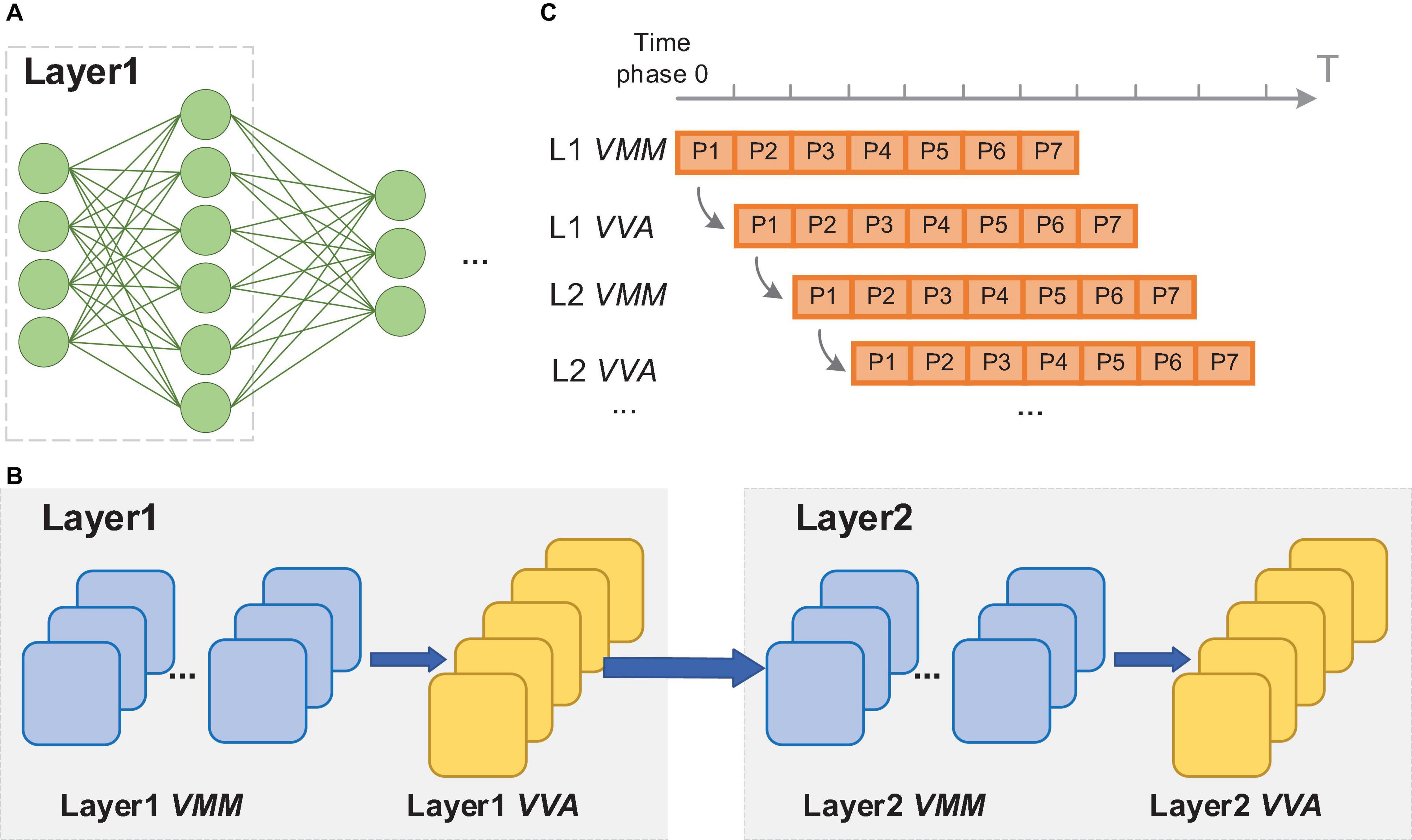
Figure 2. Illustration of the execution of the neural network on neuromorphic chips: (A) the example network structure; (B) the FCore groups after network mapping; (C) timing schedule of the FCore groups.
Overall, to end-to-end implement hybrid networks on neuromorphic chips, it requires to not only establish connections among FCore groups that support mixed dataflows, but also coordinate the different requirements of execution phases between ANNs and SNNs.
Basic Connections for Mixed Dataflow
In order to support mixed dataflows of multi-valued data and spike trains, we design three basic connections based on the fine-grained configuration of input and output modes of the FCores. According to the configuration, four kinds of FCores with different output and input relations can be formed. When the axon and the soma are configured in the same mode (either ANN or SNN mode), the FCore processes pure ANN signals in multi-value data or SNN signals in binary spikes respectively, which can be allocated to perform the calculation in ANN and SNN modules of HNNs. We call such FCores working in the pure-ANN or pure-SNN mode. When data conversion is needed, the axon and the soma are configured to work in different modes, forming hybrid FCores with ANN-input and SNN-output (A2S) or with SNN-input and ANN-output (S2A). These hybrid FCores can be used to implement the conversion between multi-valued data and spike trains, thus supporting hybrid modeling and interaction in HNNs.
By virtue of the unified routing infrastructure, these different types of FCores can formulate a variety of basic connections that enable to process single and mixed dataflows. When the soma of the pre-connected FCore and the axon of the post-connected FCore are configured in the same working mode, data can be directly transmitted between them. Figures 3A,B depict the connections that can be used to realize conversion from multi-valued data to spike trains and vice versa, respectively. In Figure 3A, the first and last FCores work in the pure-ANN and pure-SNN modes respectively. The intermediate FCore, working in the A2S mode, receives multi-valued data and converts it into binary spikes via designed internal operations. Similarly, the intermediate FCore working in the S2A mode converts the spike trains to multi-valued data in Figure 3B. In addition, as shown in Figure 3C, an ANN axon can also directly connect with an SNN soma and access neuronal state information from the routing packet. In this connection, the signal conversion occurs during data transmission and reception.
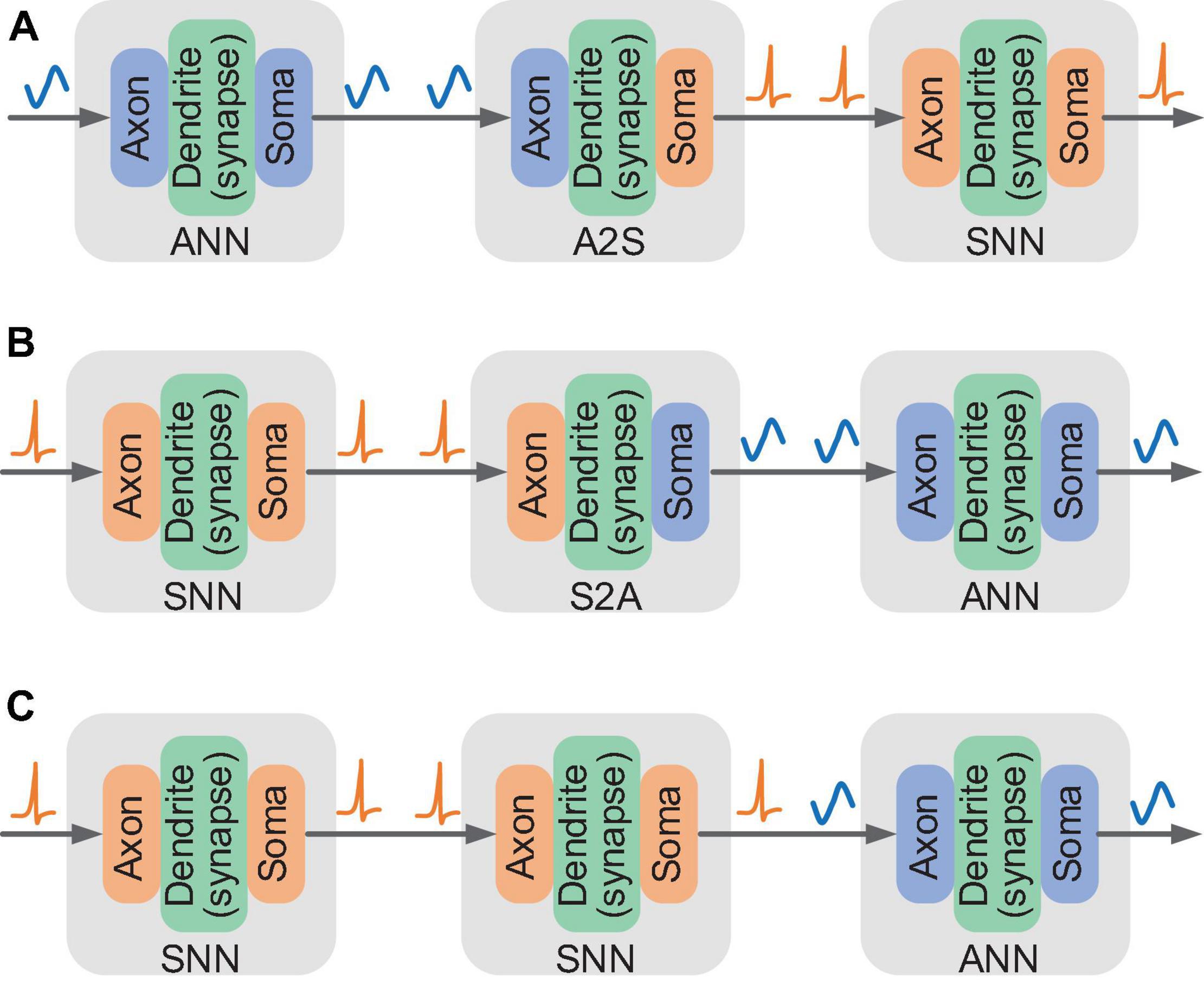
Figure 3. Illustration of three basic connections for mixed dataflow: (A) connection supporting the conversion from multi-valued data to spike trains; (B,C) connection supporting the conversion from spike trains to multi-valued data.
By constructing these basic connections for mixed dataflows, the signal conversion can be naturally performed on the critical data path of FCores without extra devices. In this manner, the signal conversion of the model can be realized on the same carrier as other components. Its effects on the execution performance of the model can be directly displayed.
Configuration Schemes for Signal Conversion
In general, different signal conversion methods are applied according to the algorithm details. The data interaction between ANNs and SNNs requires signal conversion between spike trains and multi-valued data. The commonly used data conversion methods can be summarized as: probabilistic sampling, ANN-SNN encoding layer, space expansion, and time accumulation (Deng et al., 2020b). Probabilistic sampling and ANN-SNN encoding layer are responsible for the conversion from multi-valued data to spike trains, while spatial expansion and temporal accumulation are responsible for the conversion from spike trains to multi-valued data. We establish configuration schemes for these typical signal conversions (as illustrated in Figure 4), whose operations are mapped into the configurations of the working modes of the building blocks in each FCore.

Figure 4. Illustration of the implementation of typical signal conversions: (A) probabilistic sampling; (B) ANN-SNN encoding layer; (C) spatial expansion; (D) temporal accumulation.
Probabilistic sampling converts multi-valued data to spike trains through an element-by-element operation. At each time phase in the time window, a random vector with the same size as the original multi-valued data is generated. After comparison, the multi-valued data is sampled as binary spikes. The FCores used for realizing probabilistic sampling work in the A2S mode. The axons’ input data is directly transmitted to the soma through VB operation. Their somas work in the SNN mode and the random threshold is enabled. Random numbers with uniform distribution are generated as the threshold of membrane potential, so as to realize the sampling of input multi-valued data. The update mode of membrane potential is set to keep, so that the multi-valued data can be saved after the first reception, which will be converted into a spike train latter via soma sampling with multiple time phases.
ANN-SNN encoding layer can be regarded as a special SNN layer that can process multi-valued input data. Different from probabilistic sampling, the encoding layer adopts a rank-order coding format. Before being converted into spikes, the original multi-valued data is processed by a global calculation in advance, which can be a fully connected calculation (Bellec et al., 2018), a convolution (Wu et al., 2019), or a difference-of-Gaussians (DoG) (Kheradpisheh et al., 2018). The integration results are continuously accumulated onto the membrane potential of the output neuron, and the neuron fires a spike once the membrane potential exceeds the firing threshold at any time phase. In order to reduce redundant integration operations, we implement the encoding layer in two FCore groups: integration FCores and conversion FCores. In integration FCores, the dendrite performs the VMM operation at the first time phase in a time window and stores the integration results in the shared memory. The ANN soma of FCores continuously sends out the integration results (or their partial sums) to the conversion FCores, where spikes are generated through the LIF operation in the SNN soma.
Spatial expansion directly transfers the spatio-temporal two-dimensional spike pattern into a static binary image. Each “1” in the static binary image corresponds to the existence of a spike in the original spike pattern. In hardware implementation, this spatial expansion method needs to buffer and rearrange data from different time steps. To solve this problem, we establish a self-feedback routing connection in the conversion FCore. The input spikes are shifted and sorted at each time phase. The rearranged spikes are sent to the downstream adjacent ANN axon through multicast routing as binary image data. However, in this conversion method, the scale of the newly generated binary data is proportional to the length of the time window. Consequently, it will consume massive computing and storage resources in the case of a large time window.
Temporal accumulation directly accumulates the spike train of each input node within the time window into a multi-valued data. This kind of conversion can be regarded as the reverse process of rate coding, and the converted multi-valued data has the same spatial size as the input spikes. This conversion can be realized by the TFC in axon. Spike accumulation for Tw length is enabled in TFC, and the corresponding time factors are configured as 1. In this way, the data transmitted to the dendrite module for integrated calculation is the multi-valued data obtained by accumulation. In the conversion FCore, only the axon is used for signal conversion, and the dendrite and the soma can directly execute the subsequent ANN calculations.
The configuration schemes for these typical signal conversions are summarized in Table 2. In the hybrid networks, the signal conversion operations are mapped into the configuration of the FCore according to the algorithmic computing operations. The model can generate the corresponding special conversion FCore groups in accordance with different requirements to form a connection with hybrid dataflows.
Global Adjustment of Timing Schedule
As introduced in Section “Execution of Neural Networks on Neuromorphic Chips,” ANNs and SNNs have different pipelining cycles (1 phase in ANN and Tw phases in SNN) and need to adjust the timing schedule when combining the ANN layers and SNN layers together. In hybrid models, when an ANN layer runs ahead of an SNN layer, the ANN layer is expected to wait for the SNN layer to execute Tw times continuously before transmitting the next data. Similarly, when an ANN layer runs behind an SNN layer, the ANN layer only needs to perform the calculation once after the SNN layer continuously executes Tw times. Therefore, it is preferred that in hybrid models, the ANN only starts at a suitable time for effective calculation and data transmission, instead of performing the same operation phase by phase repeatedly. Hence, we use the configurable phase pattern introduced in Section “Adjustable Timing Schedule” to realize a global timing adjustment of the timing schedule of the FCores.
We demonstrate this global adjustment mechanism in Figure 5. Figures 5B,C illustration the situation of “ANN layer to SNN layer” and “SNN layer to ANN layer” respectively. In both situations, the time step is set to include Tw time phases. In each time step, the FCore groups corresponding to the SNN calculation execute continuously, while the FCore groups corresponding to the ANN calculation only start at the first phase. Therefore, the phase patterns of these two types of FCore groups will be configured as #on_ phases = Tw, #off_ Phases = 0 and #on_ phases = 1, #off_ phases = Tw-1 respectively. Due to the delay of data transmission, different FCore groups will have different start-up time. Generally, this start-up delay is the number of FCore groups that need to pass before data arrives. However, in the mapped structure, as long as there exists an FCore group for ANN-SNN conversion, the subsequent start-up delay needs to increase the extra time required by the ANN to wait for SNN to process data (i.e., Tw-1 time phases, see Figure 5C). After setting the correct start-up delay, the ANN and SNN in the hybrid model can continually process each frame of input data in a pipelined manner, “step” by “step.”
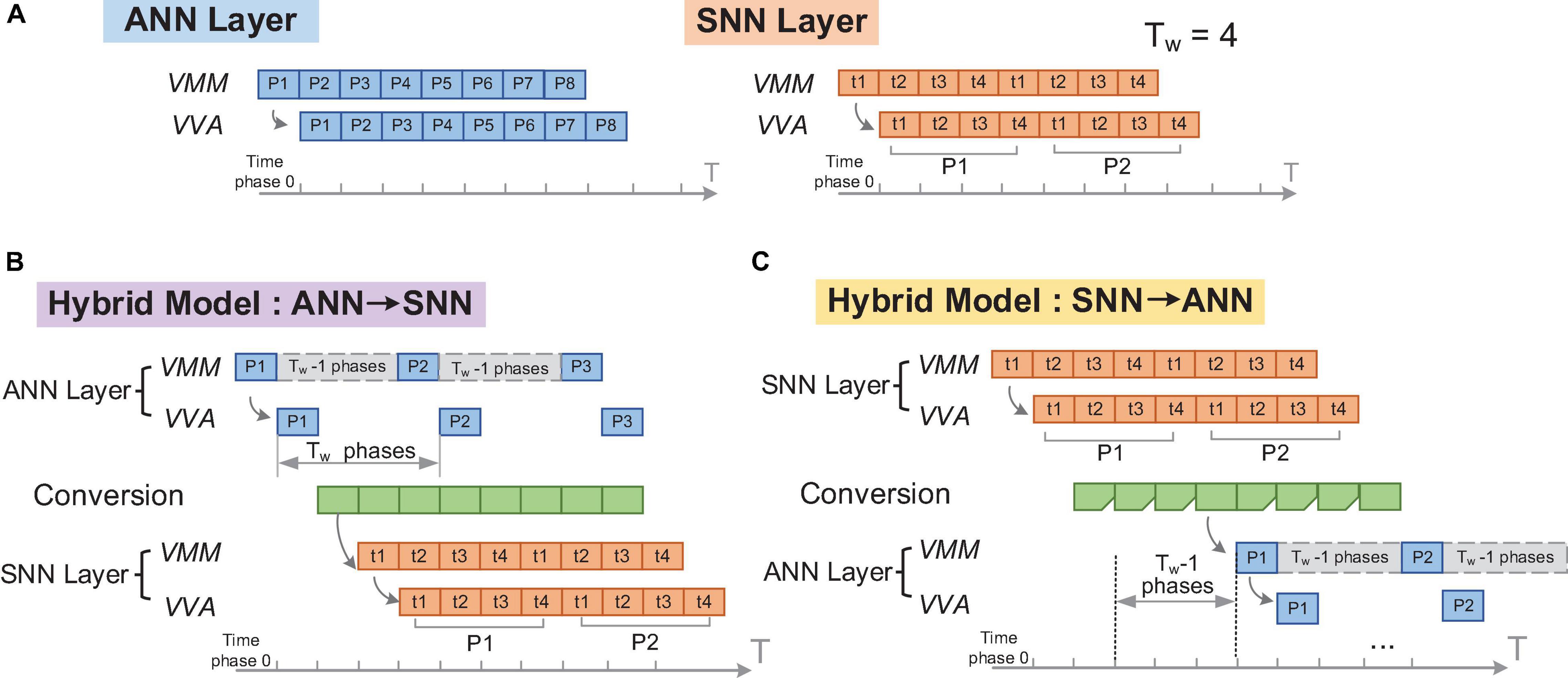
Figure 5. Illustration of the global adjustment of timing schedule: (A) original ANN and SNN layers; (B) timing configuration of an SNN layer running after an ANN layer; (C) timing configuration of an ANN layer running after an SNN layer.
As shown in the Table 2, following the same method, the dendrite and the soma in the conversion FCores are also configured to have different phase patterns to deal with the intra-FCore mixed dataflow. These timing patterns are eventually transformed into the configuration of timing registers in each FCore. Such a global timing adjustment can not only keep the original pipeline mechanism, but also reduce redundant calculations.
Experimental Results
Experimental Setup
We have built some examples of hybrid networks to verify our mapping framework and illustrate the implementation results. We chose MNIST (LeCun et al., 1998) and NMNIST (Orchard et al., 2015) data sets to demonstrate the proposed conversion approach. Each digit sample in MNIST is a 28 × 28 grayscale image and NMNIST is a neuromorphic version of MNIST with a spike pattern size of 34 × 34 × 2 at each time step. As for the network structure, we chose the fully connected structure of input-512-512-10 and the convolutional neural network structure of LeNet (LeCun et al., 1998) (input-6c5-AP2-16c5-AP2-120-84-10). The overall settings of input data, network structure and signal conversion method are shown in the Table 3.
Figure 6 shows the settings of signal conversion in these models. From Model 1 to Model 4, the signal conversion from multi-value data to spike trains happens in the first layer of the network. At the output of these models, the spikes within the time window are accumulated and converted into multi-valued data to obtain the classification results. In Model 5 and Model 6, the signal conversion from spike trains to multi-valued data occurs in the connection between the first and second hidden layers. In Model 7 and Model 8, the signal conversion is performed between the last pooling layer and the fully connected classifier.
We developed a mapping compiler in python to automatically implement the partition of networks, generation of conversion FCores, and global timing adjustment in our mapping framework. We used a direct quantization method for these hybrid models. We first loaded a pre-trained model with FP32 weights, and then followed the quantization method in Yang et al. (2020) to re-train the model by quantizing the weights into INT8 precision during each weight update. After this process, we can obtain the resource utilization report of network and the binary file for the chip configuration. At last, the configuration file is downloaded into the chip for execution, where the latency and power consumption of network execution can be measured accurately. We use a single-chip PCB equipped with an Altera Cyclone 4 FPGA as the test board. The input data is pre-stored in an SDRAM on the board, and injected into the chip through FPGA whiling testing. At 300 MHz clock, 16.8 μs is needed for a time phase.
Analysis of Resource Consumption of Various Hybrid Models on Tianjic
After mapping, these hybrid network models are transformed into the connections between FCores with four different input and output types, as described in Section “Basic Connections for Mixed Dataflow.” Figure 7 shows the resource utilization of different types of FCores in each hybrid model. When mapping the SNN part of these hybrid models, according to the method in Pei et al. (2019); Deng et al. (2020a), we transfer the partial sums calculated by VMM in the form of multi-valued data. This method can avoid the decrease of accuracy caused by the fan-in limitation of FCores in the mapping process. Therefore, when the number of input neurons in an SNN layer exceeds the fan-in of FCore, there exist S2A-type VMM FCores and A2S-type VVA FCores in the mapping result. Additionally, we define the ratio of effective computing FCores as the ratio of the number of FCores that perform network computing and the number of the total FCores. The larger the ratio of effective computing FCores is, the smaller the extra cost of signal conversion in hybrid models consumes.
In a connection with the signal conversion from multi-valued data to spike trains, the resource consumption required by the probabilistic sampling and ANN-SNN encoding layer is determined by the number of input and output neurons in the connection, respectively. In the MLP structure, the conversion takes place in a 784-512 connection. Therefore, compared with Model 2, Model 1 uses more A2S-type FCores. Similarly, in the LeNet structure, the size of input and output in the connection with signal conversion is 28 × 28 × 1 and 24 × 24 × 6, respectively, which leads to Model 4 consuming more conversion FCores than Model 3. In the implementation of probabilistic sampling and ANN-SNN encoding layer, the signal conversions are carried out through additional FCores. From Figure 7, we can see that the ratio of effective computing FCores in Model 1∼Model 4 are 84%, 96%, 92%, and 81%, respectively. This result also indicates that with the increase of the scale of converted signals, the proportion of the FCores that undertake the network computation in the hybrid model decreases.
In the implementation of spatial expansion, the conversion FCores work in the SNN mode to buffer and rearrange input spikes. As mentioned above, the FCores consumed by spatial expansion will increase with the increase of the SNN time window. To observe this trend, we show the resource consumption of Model 5 and Model 7 when Tw equals 2, 6, 10, and 14 respectively (shown as -T2, -T6, -T10 and T14 in Figure 7). As we can see, with the increase of Tw, the number of SNN-type FCores increases concomitantly, which is caused by the increase of the number of occupied conversion FCores. Furthermore, due to the growth of the scale of the converted binary image, the number of ANN-type FCores that are used to perform subsequent ANN calculations also increases. It is observed that, under the joint influence of these two kinds of growth, the ratio of effective computing FCores of the network finally shows an obvious downward trend. In the implementation of spatial expansion, only axons in the FCores are used, which does not affect the subsequent calculation of dendrites and somas. As a result, the ratios of effective computing FCores are both 100% in Model 6 and Model 8. Regardless of the types of FCores, the resource consumption of these two models is the same as that of a single-paradigm network with the same structure.
Comparison of Performance on Tianjic and GPU
We tested the implementation of these hybrid models on GPU (Nvidia RTX 2080Ti) and the Tianjic chip, respectively, and summarized the outcomes in Table 4. The time window of SNNs in these hybrid models was set as 10. These hybrid models ran on GPU with the default FP32 precision. While running on Tianjic chip, all the weights and output activations were quantized to INT8. It is observed that there is no evident difference in recognition accuracy between the fixed-point network implemented on the Tianjic chip and the floating-point network running on GPU. In some models (i.e., Model 2 and Model 7), the accuracy on the Tianjic chip was slightly improved, which is owing to the regularization effect of quantization. Generally speaking, the accuracy of the model varies within 0.15%, which is almost negligible.
It is worth noting that, while running on Tianjic, all these models consume about 300 ms latency to process one frame of data. Compared with GPU, the processing speed is increased by an average of 20 times. This is mainly due to the high computational parallelism of the many-core architecture in the Tianjic chip. In all these models, the average power consumption is below 400 mW, verifying the advantage of low power consumption compared with GPU (usually with a dynamic power of 1∼100 W).
Through the comprehensive comparison, we can conclude that when implemented on the Tianjic chip, the hybrid models not only obtain nearly lossless accuracies, but also exhibit significant advantages of low processing latency and low power consumption. In the next section, we will further analyze the energy consumption of different parts that are responsible for ANN calculations, SNN calculations, and signal conversions, respectively, in the hybrid models.
Analysis of Energy Consumption
Taking Model 5 to Model 8 as examples, we analyze the distribution of dynamic energy consumption and its change along with the time window. The dynamic energy distribution in these hybrid models when Tw equals 2, 4, 6, 8, and 10 are visualized in Figure 8. For each Tw value, the dynamic energy consumption transformation before and after the global adjustment of timing schedule are also plotted.
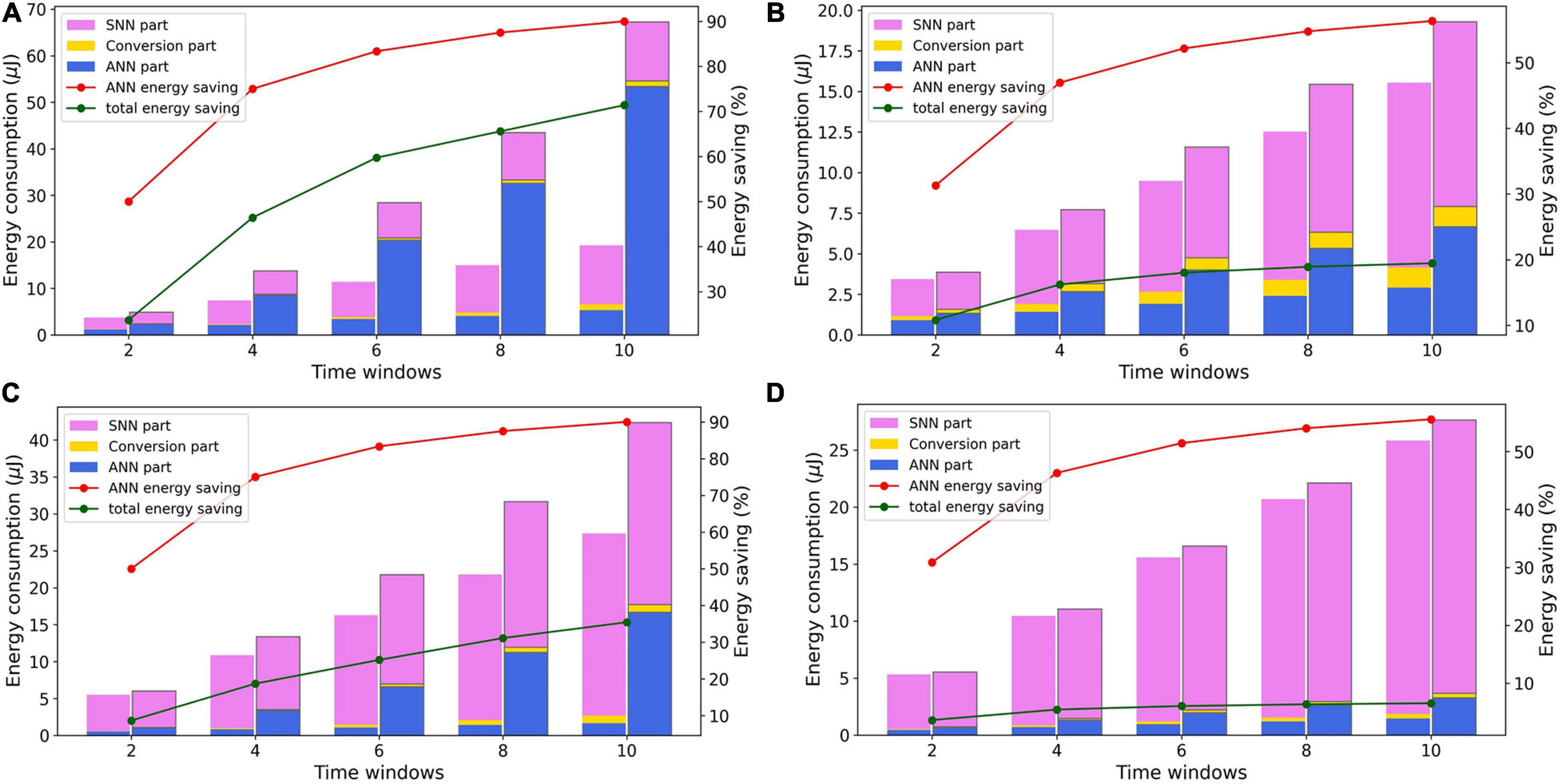
Figure 8. Variation of dynamic energy consumption distribution with time window of panels (A) Model 5, (B) Model 6, (C) Model 7, and (D) Model 8.
The Global adjustment of timing schedule can reduce the total dynamic energy consumption of network by reducing redundant ANN operations. Evidently, as the time window increases, the energy saving of the ANN calculations under the same conversion method retains the same. Model 5 and Model 7 use the spatial extension method and the input size of the ANN layer will increase along with Tw. As shown in Figure 7, the increase of the input size will consume more ANN FCores and thus more dynamic energy consumption. Nevertheless, due to the reduction of redundant operations brought by the global timing adjustment, the dynamic energy saving of ANN FCores in both Model 5 and Model 7 increases from about 50% to about 90% as Tw increases. In Model 6 and Model 8, after the global timing adjustment, there are still some VMM operations that need to be executed repeatedly in the conversion FCores to drive the shift of the axon’s spike buffer. Along with the increase of Tw, these repeated executions lead to the increase of ANN FCores’ dynamic energy consumption in the adjusted models. As a result, Model 6 and Model 8 have a lower dynamic energy saving than Model 5 and Model 7, which increases from about 31% to about 56%. Additionally, due to the different proportion of ANN and SNN, the total energy saving also differs in different models. In a hybrid network, the larger the proportion of ANN calculations is, the more energy can be saved after global timing adjustment.
After the global timing adjustment, when Tw equals 2, the energy consumptions required for signal conversion in Model 5 to Model 8 accounts for a small part, which are 7.3%, 1.6%, 1.3%, and 0.9%, respectively. With the increase of Tw, these ratios all increase slightly. In the method of spatial expansion, because the number of conversion FCores is also increasing, the proportion will rise a little faster. But these ratios do not exceed 10% in the end. Furthermore, the difference in the dynamic energy consumed by SNN and ANN calculations is not as large as the difference in the number of FCores (about 6: 1 and 10: 1 in MLP and LeNet, respectively), indicating that the advantage of the computational sparsity in SNNs is well utilized in hardware execution.
Conclusion and Discussion
In this paper, we propose a systematic solution of implementing various hybrid networks on many-core neuromorphic chips through software-hardware cooperation. Based on the abstraction of the Tianjic chip, we summarize that the fine-grained configurable basic units, unified communication format, and adjustable timing schedule provide the hardware foundation for implementation of hybrid models. On this basis, we propose an end-to-end mapping framework to facilitate implementation of hybrid models on hardware. By constructing basic connections for mixed dataflows, signal conversions are performed on the critical data paths of FCores without requiring additional devices. The configuration schemes for the typical four types of signal conversions are designed and proved to promote the mapping of the operations in hybrid models into FCores in the same way as that of the networks’ computing operation. The global adjustment of timing schedule not only ensures the continuity and correctness of data transmission and processing in the network, but also reduces the energy consumption caused by the repeated redundant calculations. Furthermore, we built a tool chain to automatically implement the mapping framework. By mapping typical hybrid models to the Tianjic chip, we demonstrate that these models not only obtain almost lossless accuracy compared with the general computing platform, but also exhibit significant advantages of low execution latency and low power consumption. The results of the experiment show that although the implementation of signal conversion in HNNs generates additional resource overhead, the overall energy consumption of the network can be significantly reduced by disabling repeated redundant operations.
Generally, SNNs have rich coding schemes to encode information in spatio-temporal domain, including rate coding schemes (Deng et al., 2020b) and temporal coding schemes like rank-order coding schemes (Tang et al., 2020), inter-spike interval based (Dong et al., 2019) and time-to-first spike based encoding schemes (Liu and Yue, 2017; Mostafa, 2017). Our framework can effectively support the rate coding and rank-order coding scheme for SNNs and in principle can support the temporal coding schemes via the unified communication format. The unified communication format can directly transmit the temporal information through its data segment (i.e., 8-bit Fire_data in the routing packet) to support the inter-spike interval based and time-to-first spike based encoding schemes. To effectively support these temporal coding schemes, efficient capture of the absolute or interval time information of each neuron’s output spikes is necessary and requires further improved hardware design.
With the increasing complexity of tasks and the deepening of artificial intelligence research, it is expected that more and further cross-paradigm fusions of ANNs and SNNs will emerge. Hence, we are convinced that our proposed end-to-end hardware implementation method will provide a systematic solution to map hybrid models onto neuromorphic chips, and provide guidance for further development of hybrid neural models. Moreover, through the modeling abstraction of hardware characteristics, mapping mechanisms can be established to fully explore the potential of the hardware carrier and support more complex algorithm models. Through the iteration of hardware-software co-optimization, it is highly possible to develop a general brain-inspired computing platform that can handle more complex tasks.
Data Availability Statement
The original contributions presented in the study are included in the article/supplementary material, further inquiries can be directed to the corresponding author/s.
Author Contributions
GW proposed the idea, designed and did the experiments, and wrote the manuscript. GW and YW conducted the algorithm modeling work. GW, SM, and JP conducted the design and implementation of the hardware testing platform. GW and SM contributed to the analysis and interpretation of results. RZ led the discussion and revised it. LS directed the project and provided overall guidance. All authors contributed to the article and approved the submitted version.
Funding
This work was partly supported by the National Key R&D Program of China 2018YFE0200200, National Nature Science Foundation of China (No. 61836004), Brain-Science Special Program of Beijing under grants Z181100001518006 and Z191100007519009, the Suzhou-Tsinghua innovation leading program 2016SZ0102, and CETC Haikang Group-Brain Inspired Computing Joint Research Center.
Conflict of Interest
The authors declare that the research was conducted in the absence of any commercial or financial relationships that could be construed as a potential conflict of interest.
References
Akopyan, F., Sawada, J., Cassidy, A., Alvarez-Icaza, R., Arthur, J., Merolla, P., et al. (2015). Truenorth: design and tool flow of a 65 mw 1 million neuron programmable neurosynaptic chip. IEEE Trans. Comput. Aided Des. Integr. Circ. Syst. 34, 1537–1557. doi: 10.1109/TCAD.2015.2474396
Bellec, G., Salaj, D., Subramoney, A., Legenstein, R., and Maass, W. (2018). “Long short-term memory and learning-to-learn in networks of spiking neurons,” in Proceedings of the 32nd Conference on Neural Information Processing System Montreal.
Chancán, M., Hernandez-Nunez, L., Narendra, A., Barron, A. B., and Milford, M. (2020). A hybrid compact neural architecture for visual place recognition. IEEE Robot. Autom. Lett. 5, 993–1000. doi: 10.1109/LRA.2020.2967324
Chen, Y., Luo, T., Liu, S., Zhang, S., He, L., Wang, J., et al. (2014). Dadiannao: a machine-learning supercomputer. Paper Presented at the 2014 47th Annual IEEE/ACM International Symposium on Microarchitecture (New Jersey, NJ: IEEE). doi: 10.1109/MICRO.2014.58
Chen, Y.-H., Yang, T.-J., Emer, J., and Sze, V. (2019). Eyeriss v2: a flexible accelerator for emerging deep neural networks on mobile devices. IEEE J. Emerg. Sel. Top. Circuits Syst. 9, 292–308. doi: 10.1109/JETCAS.2019.2910232
Davies, M., Srinivasa, N., Lin, T.-H., Chinya, G., Cao, Y., Choday, S. H., et al. (2018). Loihi: a neuromorphic manycore processor with on-chip learning. IEEE Micro 38, 82–99. doi: 10.1109/MM.2018.112130359
Deng, L., Liang, L., Wang, G., Chang, L., Hu, X., Ma, X., et al. (2018). Semimap: a semi-folded convolution mapping for speed-overhead balance on crossbars. IEEE Trans. Comput. Aided Des. Integr. Circ. Syst. 39, 117–130. doi: 10.1109/TCAD.2018.2883959
Deng, L., Wang, G., Li, G., Li, S., Liang, L., Zhu, M., et al. (2020a). Tianjic: a unified and scalable chip bridging spike-based and continuous neural computation. IEEE J. Solid State Circ. 55, 2228–2246. doi: 10.1109/JSSC.2020.2970709
Deng, L., Wu, Y., Hu, X., Liang, L., Ding, Y., Li, G., et al. (2020b). Rethinking the performance comparison between SNNS and ANNS. Neural Netw. 121, 294–307. doi: 10.1016/j.neunet.2019.09.005
Dong, S., Zhu, L., Xu, D., Tian, Y., and Huang, T. (2019). “An efficient coding method for spike camera using inter-spike intervals,” in Proceedings of the 2019 Data Compression Conference (New Jersey, NJ: IEEE). doi: 10.1109/DCC.2019.00080
Esser, S. K., Andreopoulos, A., Appuswamy, R., Datta, P., Barch, D., Amir, A., et al. (2013). “Cognitive computing systems: algorithms and applications for networks of neurosynaptic cores,” in Proceedings of the The 2013 International Joint Conference on Neural Networks (New Jersey, NJ: IEEE). doi: 10.1109/IJCNN.2013.6706746
Esser, S. K., Merolla, P. A., Arthur, J. V., Cassidy, A. S., Appuswamy, R., Andreopoulos, A., et al. (2016). Convolutional networks for fast, energy-efficient neuromorphic computing. Proc. Natl. Acad. Sci. USA 113, 11441–11446. doi: 10.1073/pnas.1604850113
Furber, S. B., Galluppi, F., Temple, S., and Plana, L. A. (2014). The spinnaker project. Proc. IEEE 102, 652–665. doi: 10.1109/JPROC.2014.2304638
Ghosh-Dastidar, S., and Adeli, H. (2009). Spiking neural networks. Int. J. Neural Syst. 19, 295–308. doi: 10.1142/S0129065709002002
Haessig, G., Cassidy, A., Alvarez, R., Benosman, R., and Orchard, G. (2018). Spiking optical flow for event-based sensors using IBM’s truenorth neurosynaptic system. IEEE Trans. Biomed. Circ. Syst. 12, 860–870. doi: 10.1109/TBCAS.2018.2834558
Han, S., Liu, X., Mao, H., Pu, J., Pedram, A., Horowitz, M. A., et al. (2016). EIE: efficient inference engine on compressed deep neural network. SIGARCH Comput. Archit. News 44, 243–254. doi: 10.1145/3007787.3001163
He, K., Zhang, X., Ren, S., and Sun, J. (2016). “Deep residual learning for image recognition,” in Proceedings of the IEEE Conference on Computer Vision and Pattern Recognition (New Jersey, NJ: IEEE). doi: 10.1109/CVPR.2016.90
Ji, Y., Zhang, Y., Chen, W., and Xie, Y. (2018). “Bridge the gap between neural networks and neuromorphic hardware with a neural network compiler,” in Proceedings of the 23rd International Conference on Architectural Support for Programming Languages and Operating Systems (Williamsburg, VA: ASPLoS). doi: 10.1145/3173162.3173205
Jiao, Y., Han, L., Jin, R., Su, Y.-J., Ho, C., Yin, L., et al. (2020). “7.2 A 12nm programmable convolution-efficient neural-processing-unit chip achieving 825TOPS,” in Proceedings of the 2020 IEEE International Solid-State Circuits Conference-(ISSCC) (New Jersey, NJ: IEEE). doi: 10.1109/ISSCC19947.2020.9062984
Jouppi, N. P., Young, C., Patil, N., Patterson, D., Agrawal, G., Bajwa, R., et al. (2017). “In-datacenter performance analysis of a tensor processing unit,” in Proceedings of the 44th Annual International Symposium on Computer Architecture Toronto.
Kheradpisheh, S. R., Ganjtabesh, M., Thorpe, S. J., and Masquelier, T. (2018). STDP-based spiking deep convolutional neural networks for object recognition. Neural Netw. 99, 56–67. doi: 10.1016/j.neunet.2017.12.005
Lam, M. W., Chen, X., Hu, S., Yu, J., Liu, X., and Meng, H. (2019). Gaussian process Lstm recurrent neural network language models for speech recognition. Paper Presented at the ICASSP 2019-2019 IEEE International Conference on Acoustics, Speech and Signal Processing (ICASSP) (New Jersey, NJ: IEEE). doi: 10.1109/ICASSP.2019.8683660
Lecun, Y., Bengio, Y., and Hinton, G. (2015). Deep learning. Nature 521:436. doi: 10.1038/nature14539
LeCun, Y., Bottou, L., Bengio, Y., and Haffner, P. (1998). Gradient-based learning applied to document recognition. Proc. IEEE 86, 2278–2324. doi: 10.1109/5.726791
Lee, C., Kosta, A., Zhu, A. Z., Chaney, K., Daniilidis, K., and Roy, K. (2020). Spike-flownet: event-based optical flow estimation with energy-efficient hybrid neural networks. [arXiv Preprint] Available online at: https://arxiv.org/abs/2003.06696 (accessed October 1, 2020).
Liu, D., and Yue, S. (2017). Fast unsupervised learning for visual pattern recognition using spike timing dependent plasticity. Neurocomputing 249, 212–224. doi: 10.1016/j.neucom.2017.04.003
Maass, W. (1997). Networks of spiking neurons: the third generation of neural network models. Neural Netw. 10, 1659–1671. doi: 10.1016/S0893-6080(97)00011-7
Mahowald, M. (1993). The Address-Event Representation Communication Protocol. AER 0.02. (Pasadena, CA: California Institute of Technology).
Marblestone, A. H., Wayne, G., and Kording, K. P. (2016). Toward an integration of deep learning and neuroscience. Front. Comput. Neurosci. 10:94. doi: 10.3389/fncom.2016.00094
Merolla, P. A., Arthur, J. V., Alvarez-Icaza, R., Cassidy, A. S., Sawada, J., Akopyan, F., et al. (2014). A million spiking-neuron integrated circuit with a scalable communication network and interface. Science 345, 668–673. doi: 10.1126/science.1254642
Mostafa, H. (2017). Supervised learning based on temporal coding in spiking neural networks. IEEE Trans. Neural Netw. Learn. Syst. 29, 3227–3235. doi: 10.1109/TNNLS.2017.2726060
Orchard, G., Jayawant, A., Cohen, G. K., and Thakor, N. (2015). Converting static image datasets to spiking neuromorphic datasets using saccades. Front. Neurosci. 9:437. doi: 10.3389/fnins.2015.00437
Pei, J., Deng, L., Song, S., Zhao, M., Zhang, Y., Wu, S., et al. (2019). Towards artificial general intelligence with hybrid Tianjic chip architecture. Nature 572, 106–111. doi: 10.1038/s41586-019-1424-8
Shao, Y. S., Clemons, J., Venkatesan, R., Zimmer, B., Fojtik, M., Jiang, N., et al. (2019). “Simba: scaling deep-learning inference with multi-chip-module-based architecture,” in Proceedings of the 52nd Annual IEEE/ACM International Symposium on Microarchitecture (New Jersey, NJ: IEEE).
Shi, G., Liu, Z., Wang, X., Li, C. T., and Gu, X. (2017). Object-dependent sparse representation for extracellular spike detection. Neurocomputing 266, 674–686. doi: 10.1016/j.neucom.2017.05.082
Shukla, R., Lipasti, M., Van Essen, B., Moody, A., and Maruyama, N. (2019). REMODEL: rethinking deep CNN models to detect and count on a NeuroSynaptic system. Front. Neurosci. 13:4. doi: 10.3389/fnins.2019.00004
Srinivasan, G., and Roy, K. (2019). Restocnet: residual stochastic binary convolutional spiking neural network for memory-efficient neuromorphic computing. Front. Neurosci. 13:189. doi: 10.3389/fnins.2019.00189
Sze, V., Chen, Y.-H., Yang, T.-J., and Emer, J. S. (2017). Efficient processing of deep neural networks: a tutorial and survey. Proc. IEEE 105, 2295–2329. doi: 10.1109/JPROC.2017.2761740
Tang, H., Cho, D., Lew, D., Kim, T., and Park, J. (2020). Rank order coding based spiking convolutional neural network architecture with energy-efficient membrane voltage updates. Neurocomputing 407, 300–312. doi: 10.1016/j.neucom.2020.05.031
Ullman, S. (2019). Using neuroscience to develop artificial intelligence. Science 363, 692–693. doi: 10.1126/science.aau6595
Wu, J., Wang, G., Yang, W., and Ji, X. (2016). Action recognition with joint attention on multi-level deep features. [arXiv Preprint] Available online at: https://arxiv.org/abs/1607.02556 (accessed October 1, 2020).
Wu, Y., Deng, L., Li, G., Zhu, J., Xie, Y., and Shi, L. (2019). Direct training for spiking neural networks: faster, larger, better. Paper Presented at the Proceedings of the AAAI Conference on Artificial Intelligence (Menlo Park, CL: AAAI). doi: 10.1609/aaai.v33i01.33011311
Yang, Y., Deng, L., Wu, S., Yan, T., Xie, Y., and Li, G. (2020). Training high-performance and large-scale deep neural networks with full 8-bit integers. Neural Netw. 125, 70–82. doi: 10.1016/j.neunet.2019.12.027
Yang, Z., Wu, Y., Wang, G., Yang, Y., Li, G., Deng, L., et al. (2019). DashNet: a hybrid artificial and spiking neural network for high-speed object tracking. [arXiv Preprint] Available online at: https://arxiv.org/abs/1909.12942 (accessed October 1, 2020).
Keywords: hybrid neural networks, cross-paradigm computing, neuromorphic chip, mapping framework, end-to-end implementation
Citation: Wang G, Ma S, Wu Y, Pei J, Zhao R and Shi L (2021) End-to-End Implementation of Various Hybrid Neural Networks on a Cross-Paradigm Neuromorphic Chip. Front. Neurosci. 15:615279. doi: 10.3389/fnins.2021.615279
Received: 08 October 2020; Accepted: 08 January 2021;
Published: 02 February 2021.
Edited by:
Huajin Tang, Zhejiang University, ChinaCopyright © 2021 Wang, Ma, Wu, Pei, Zhao and Shi. This is an open-access article distributed under the terms of the Creative Commons Attribution License (CC BY). The use, distribution or reproduction in other forums is permitted, provided the original author(s) and the copyright owner(s) are credited and that the original publication in this journal is cited, in accordance with accepted academic practice. No use, distribution or reproduction is permitted which does not comply with these terms.
*Correspondence: Luping Shi, lpshi@tsinghua.edu.cn
 Guanrui Wang
Guanrui Wang Songchen Ma
Songchen Ma Yujie Wu
Yujie Wu Jing Pei
Jing Pei Rong Zhao
Rong Zhao Luping Shi
Luping Shi